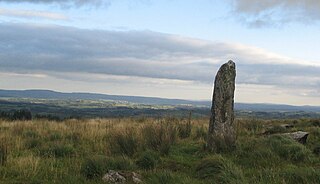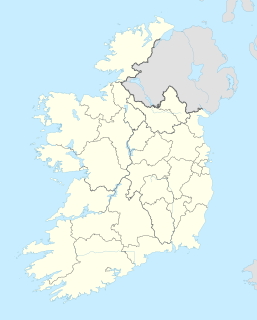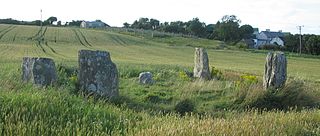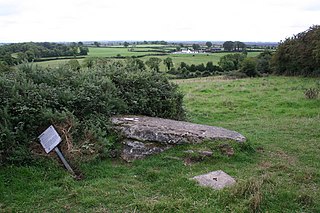| Kildun Standing Stones | |
|---|---|
| Native name Irish: Galláin Chill Ghoin | |
| Type | Standing stones |
| Location | Kildun, Ballycroy, County Mayo, Ireland |
| Coordinates | 53°59′19″N9°50′23″W / 53.988664°N 9.839678°W Coordinates: 53°59′19″N9°50′23″W / 53.988664°N 9.839678°W |
| Elevation | 23 m (75 ft) |
| Built | 2000 BC? |
| Official name: Kildun Standing Stones | |
| Reference no. | 423 |
Kildun Standing Stones are standing stones, forming a National Monument, located in County Mayo, Ireland. [1] [2]

A menhir, standing stone, orthostat, or lith is a large man-made upright stone, typically dating from the European middle Bronze Age. They can be found solely as monoliths, or as part of a group of similar stones. Menhirs' size can vary considerably, but they are generally uneven and squared, often tapering towards the top.

County Mayo is a county in Ireland. In the West of Ireland, in the province of Connacht, it is named after the village of Mayo, now generally known as Mayo Abbey. Mayo County Council is the local authority. The population was 130,507 at the 2016 census. The boundaries of the county, which was formed in 1585, reflect the Mac William Íochtar lordship at that time.

Ireland, also known as the Republic of Ireland, is a country in north-western Europe occupying 26 of 32 counties of the island of Ireland. The capital and largest city is Dublin, which is located on the eastern side of the island. Around a third of the country's population of 4.8 million people resides in the greater Dublin area. The sovereign state shares its only land border with Northern Ireland, a part of the United Kingdom. It is otherwise surrounded by the Atlantic Ocean, with the Celtic Sea to the south, St George's Channel to the south-east, and the Irish Sea to the east. It is a unitary, parliamentary republic. The legislature, the Oireachtas, consists of a lower house, Dáil Éireann, an upper house, Seanad Éireann, and an elected President who serves as the largely ceremonial head of state, but with some important powers and duties. The head of government is the Taoiseach, who is elected by the Dáil and appointed by the President; the Taoiseach in turn appoints other government ministers.








